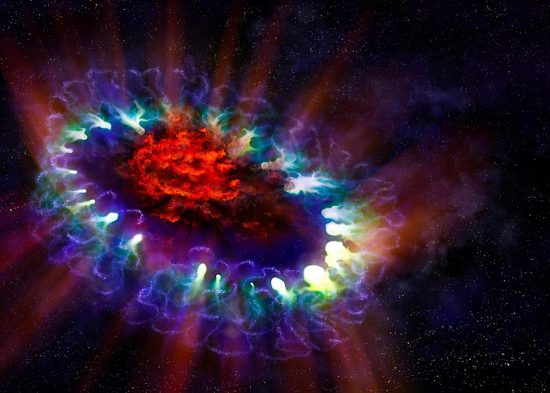
October 30, 2020
Dusty space.
According to astronomers, stars condense out of protoplanetary nebulae. X-ray emissions from such clouds are thought to indicate new fusion reactions are beginning.
As previously written, supernovae send shockwaves into regions of greater density, compressing the wispy dust and gas. That process is what is supposed to power star formation. How shock waves travel through the incredibly rarified medium of interstellar space until they encounter a nebular cloud is not known, however. Since there is only about one atom per cubic centimeter in the Interstellar Medium (ISM), no one can explain the propagation of a shock wave.
Free-floating nebular dust is just 0.1 microns in size (smaller than the wavelength of blue light). According to the “cosmic dust cycle”, some stars blow off incredible quantities when they explode. On February 23, 1987 the now-famous supernova, 1987A, lit-up a ring of gas and dust many times larger than the Solar System. The explosion was so powerful that it glowed in visible, extreme ultraviolet, and X-ray wavelengths.
In 2010 the Herschel Space Observatory observed the supernova. Dust in the ring was measured to be -100 Celsius and -250 Celsius, only a few degrees above absolute zero. Space scientists were astounded when they estimated that it exceeds 6 × 10^30 kilograms—more than 200,000 Earths!
As previously written, the NASA Ames Research Center in San Jose, California created particles of space dust using a device known as the Cosmic Simulation Chamber (COSmIC). A spray of hydrocarbon molecules was injected into a vacuum chamber, where they were “processed” in an electric discharge. Particles about 10 nanometers in size were formed, with some as large as 1.5 micrometers in diameter, about a tenth the width of a human hair.
Astrophysicists believe that dust is created in supernovae. Scientists using a cold vacuum chamber with a powerful electric discharge are “recreating” those events. Electricity is rearing its glowing head.
The Picture of the Day makes a point that stars are composed of plasma, the “fourth state” of matter. Plasma is ionized: one or more electrons are stripped from the atoms in its substance, making it electrically charged. Plasma behaves according to the tenets of electromagnetic physics.
Laboratory experiments confirm that electricity flowing through plasma forms double layers. This is the “charge separation” so often mentioned in these pages. Could charge separation be the foundation for the electrical explosions known as supernovae?
In an electrically charged plasma star, explosions occur because of double layer breakdowns. A star’s power comes from external currents of electric charge flowing through vast circuits in space. Instead of “core rebound” or “white dwarf accretion”, supernovae are the result of a stellar “circuit breaker”, where the stored electromagnetic energy in the circuit is suddenly focused at one point.
When a star’s double layer explodes, the electromagnetic energy stored in its galactic circuit surges into the explosion. The resulting supernova radiation is emitted across the entire electromagnetic spectrum from radio to gamma rays. So, it is electricity that causes the stars to shine, and it is electricity that causes them to explode. Dust is formed in supernovae, so it is ironic that consensus science needs an electric discharge to create it in the laboratory.
Stephen Smith
The Thunderbolts Picture of the Day is generously supported by the Mainwaring Archive Foundation.












